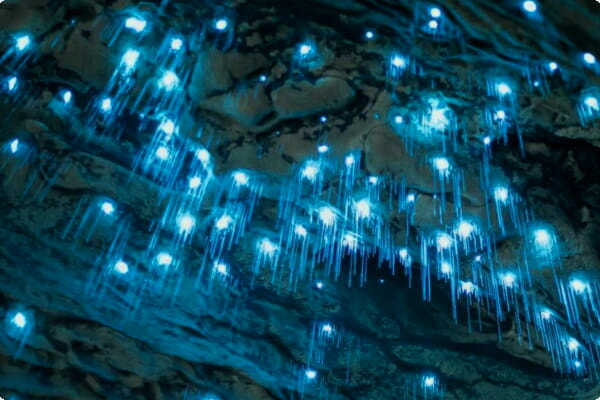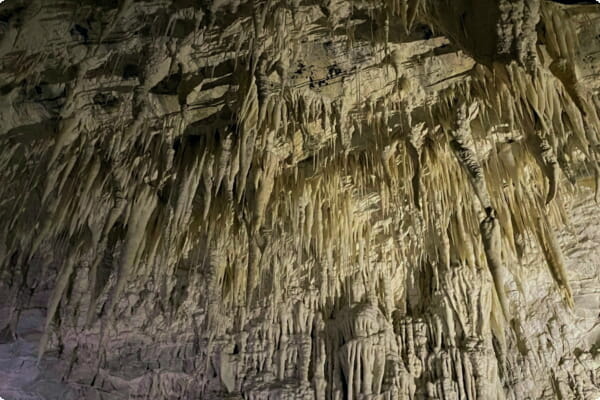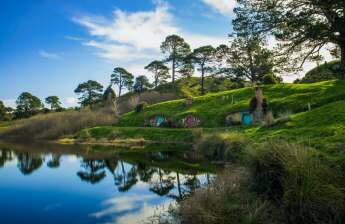Located on New Zealand's North Island, Waitomo is a village that has many interesting facts about the caves and waterfalls that are found in the area. The underground caves are home to thousands of glow-worms and a large variety of limestone formations. A high limestone arch called the Mangapohue Natural Bridge spans over the Mangapohue Stream. It is also home to the Otorohanga Kiwi House, which is a building that protects the rare native kiwi bird.
Glowworms
Thousands of glowing creatures call Waitomo Glowworm Caves home. They are found in an underground limestone grottoes that formed 30 million years ago.
These animals are referred to as Arachnocampa luminosa, and are unique to New Zealand. Their light is caused by a chemical reaction known as bioluminescence. They attract insects with their blue light and lure them to their prey.

When the glow worms are luminous, they can trick flies into thinking the light is the entrance to the cave. They then reel in line to catch their prey. They are about the size of a mosquito. They have an orb-like gland in their tail that produces a ghostly blue light.
You can view the glow worms on a guided night trip. If you plan ahead, you can get the tour you want.
Limestone formations
Among the most beautiful natural sights in New Zealand, Waitomo Caves are located on the North Island of the country. They are formed by limestone. These formations are about 30 million years old. They are part of the Waitomo district, which is home to several other karst caves.
The Waitomo district is located about 2.5 hours by road from Auckland, on the North Island of New Zealand. It has a mountainous backbone with sheltered bays along the west. It is a favourite holiday destination for many New Zealanders.
The first time the area was explored was in 1887. This was done by a local Maori named Tane Tinorau. He and his wife Huti led groups around the caves for a small fee.
Stalactites
Located on the North Island of New Zealand, Waitomo Caves are a subterranean wonder of nature. These caves are filled with limestone formations. They formed when the region was under water 30 million years ago. These formations were made up of fossilized marine organisms that have been compressed and layered upon each other.
Waitomo Caves are also known for their glowworms. These are carnivores that create a bluish green luminescent effect. They hatch into an insect-like creature and last for up to a year in the larval stage. The worms are indigenous to New Zealand.
To enjoy this natural wonder, you will need to take a guided tour. The guide will explain the history of the caves and the Maori culture. This tour is suitable for all ages. You can book your tour in advance. You will be provided with all the necessary equipment.

Guided tours
Whether you want to see the amazing glowworms or take a black water rafting tour, Waitomo Caves have something to offer. The limestone caves of Waitomo are home to incredible formations and are one of the most popular attractions in New Zealand. Located in the King Country region of southern Waikato, these caves are open year round.
Guided tours of Waitomo Caves can be booked through online tour operators. They are offered on a number of different lengths and will allow you to explore the caves in a safe and fun way.
If you would like to visit Waitomo Caves, you should book in advance. The caves are only accessible by guided tour. There are five different companies that offer glowworm cave tours. These vary in length, cost, and ability level.
Arachnocampa Luminosa
Located on the North Island of New Zealand, the Waitomo Glowworm Caves are a unique attraction for visitors. This area has been a popular tourist destination for over 100 years. They are home to Arachnocampa luminosa, which is a glow-worm species found only in the region.
The glow-worms are small bioluminescent insects that emit a blue-green light. Their light is produced when chemicals in their tail react with the oxygen in the air. These bioluminescent insects prey on flying insects, which are attracted to the light.
The Waitomo Glowworm Caves feature Arachnocampa Luminosa, which is a species found only in New Zealand. It produces its light by using acyl-CoA synthetases. The Arachnocampa Luminosa is one of nine species in the Arachnocampa genus, all of which are endemic to New Zealand.




